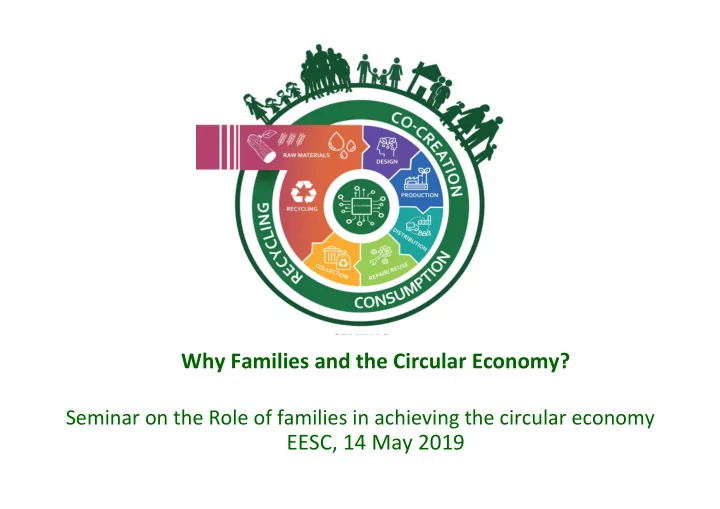

Why Families and the Circular Economy? Seminar on the Role of families in achieving the circular economy EESC, 14 May 2019
Eurobarometer on attitudes of citizens towards the environment: Why users/ consumers are not 94% protecting the environment is more involved in the circular important economy? 87% agree that they can play a role
• Identify Families’ real needs by involving them (Surveys, Living Labs, Adequate tools) • Segment Target groups such as FAMILIES and develop tailored solutions • Gather Good Practices and Benefits integrating consumer insights into CE strategies • Take Concrete actions inviting ALL actors to participate and not only top down approach • Change the narrative: make it relevant/accessible/affordable for ALL families
A circular economy approach for lifecycles of products and services
• Horizon 2020 Call: CIRC-01-2016-2017 Systemic eco-innovative approaches for the circular economy: large-scale demonstration projects • Aim : to develop & implement a circular economy approach by developing new sustainable products and services in 4 sectors • Consortium: 17 partners from 8 EU countries • Budget : Over 7M Euros including EU funding of 6,3M Euros • Duration : Three year project: (05/2018 - 04/2021) This project has received funding from the European Union’s Horizon 2020 research and innovation programme under grant agreement No 776503
With end-users C o l l a b o r a t i v e Recycling and reuse Sustainable Consumption
CO-CREATION OF PRODUCTS/ SERVICES MODEL • Bring end-users closer to the design and manufacturing phases by: § identifying consumer preferences via Big-data mining product reviews § evaluating product specifications and prototypes via Living Labs to customise end-user requirements § Innovation camps • Develop a method to calculate eco-points of products • Consumer Surveys : § Feedback and preferences on the developed products § Attitudes and understanding on the eco-point calculation 9
LIVING LABS • Framework for involving actual customers and other key stakeholders in a collaborative innovation process including families as potential costumers • Interative process that facilitates end-users, key stakeholders and partners to co- create novel solutions for all stages of the CE
CIRCULAR ECONOMY JAM • Co-create circular economy solutions for a university • Service design workshop divided into 7 challenges • 2-day event to share insights, discover new possibilities and develop new ideas around university operations and campus life • Ideas turned into a plan of actions, concepts and physical prototypes
OVERVIEW OF ECO-POINTS • Eco-point is a cumulative value which accounts for an aggregate of the environmental and health impacts throughout the product’s whole value chain • Life cycle impact assessment is used to calculate the eco-points of products 14/05/19 H2020-776503-CIRC4Life 12
APPLICATION OF THE ECO-POINT: ECO-SHOPPING • To enable consumers to view eco-impacts and sustainable manufacturing information of products using their smartphones • RFID tags and barcodes embedded in the products placed on shelves to obtain the product’s sustainable information, facilitating consumers decision to select more sustainable products 14/05/19 H2020-776503-CIRC4Life 13
APPLICATION OF ECO-POINTS: CONSUMER’S ECO- ACCOUNT Eco-debits Eco-credits earned Products Eco-credit balance (via purchasing) (via recycling) Computer -18 18 0 Book -7 0 -7 • Eco-account enables consumers to record and track their daily footprints on environment. • Eco-credits : consumers earn via recycling and reusing the products. • Eco-debits are resulted from purchase, which are offset with eco-credits • Eco-credit balance : sum of the eco-debits and eco-credits earned, which reflects the consumer’s overall impact footprints. 14/05/19 H2020-776503-CIRC4Life 14
EXAMPLE OF A CONSUMER «TRACKER» TOOL • Integrated Mobile application to help the user navigate and become an actor in the circular economy • Allowing to take full responsibility for consumption patterns, impacts and use of resources • Allowing users to become active caretakers of the resources and efficiently manage them in all phases including incentive schemes • One-stop shop for getting product and usage information, recycling processes, re-use markets, services etc.
SUSTAINABLE CONSUMPTION MODEL Method to calculate the eco-points of products based on the LCIA approach by: • Assessing Product Environmental Footprints • Traceability solution to monitor product’s sustainability along the value chain • Supporting end-users and stakeholders to actively implement the circular economy via awareness raising and knowledge sharing activities 14/05/19 H2020-776503-CIRC4Life 16
COLLABORATIVE RECYCLING/ REUSE MODEL • Develop a system for stakeholders to interact with each other to: • Facilitate recycling/reuse of end-of-life products • Reduce waste • Implement the eco-credits awarding scheme to encourage people to recycle/reuse • Consumer Surveys on : • Attitudes to recycling/reuse practices • Product End of Life information 14/05/19 17
DEMONSTRATOR 1A: DOMESTIC LED • Development of a lamp with recycled or recyclable components using co-creation: surveys, workshops etc • Sustainable consumption will be encouraged by showing the eco-points information of the new lamps • Collaborative recycling: extending the lighting products recycling practices to end- users, enabling citizens to separate and recycle the products
DEMONSTRATOR 1B: LED • Development of a modular LED industrial lamp • Development of a leasing service covering the whole life-cycle of the lighting solution in order to reduce waste and reuse/ recycle/ remanufacture • Identity consumer’s needs by using co-creation approach with potential customers and other stakeholders: Living Labs
DEMONSTRATOR 2: TABLETS • Defining & demonstrating an efficient collection system for tablet’s reuse/ remanufacturing: Integrity of the equipment • Traceability • Destination of his equipment • Reward of user’s positive actions • • Design and implementation of an incentive scheme for improving reuse/ recycling • Work in schools: • Source of information for stakeholders • Collecting info from potential end-users of reused tablets
DEMONSTRATOR 3: MICROFARMING Sustainable production to increase value and reduce waste by involving customers by: • Improving community composting • Developing new food organic products
DEMONSTRATOR 4: MEAT SUPPLY CHAIN • Co-creation of new sustainable products with consumers • Encouraging sustainable consumption by providing eco-points • Fostering recycling via incentive schemes
Project Website: www.circ4life.eu www.facebook.com/CIRC4Life www.linkedin.com/company/circ4life-eu @CIRC4L
Recommend
More recommend